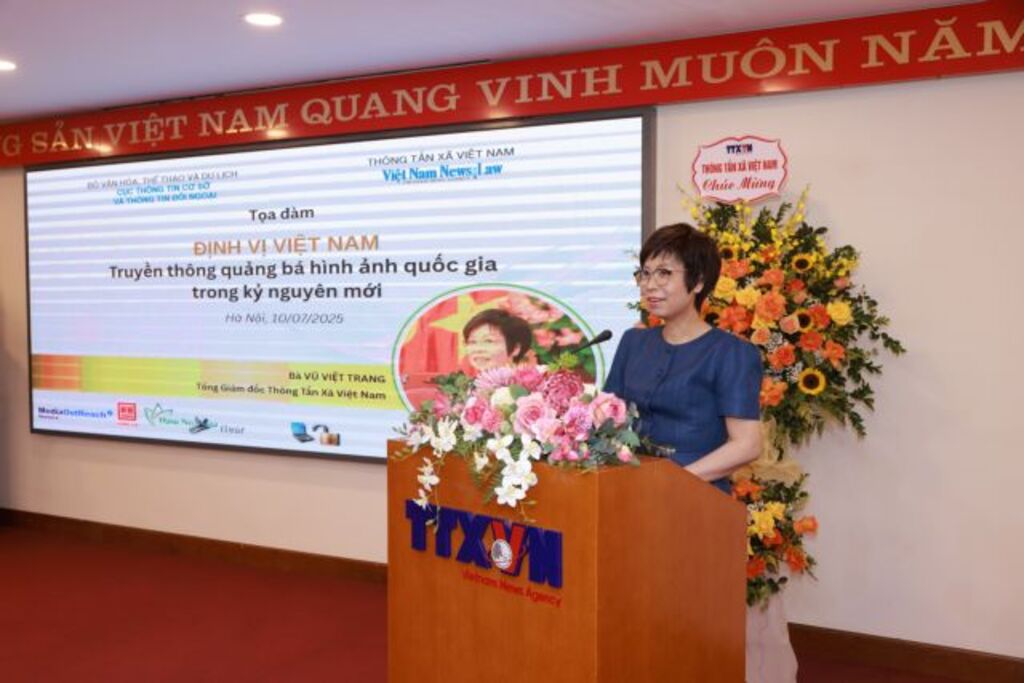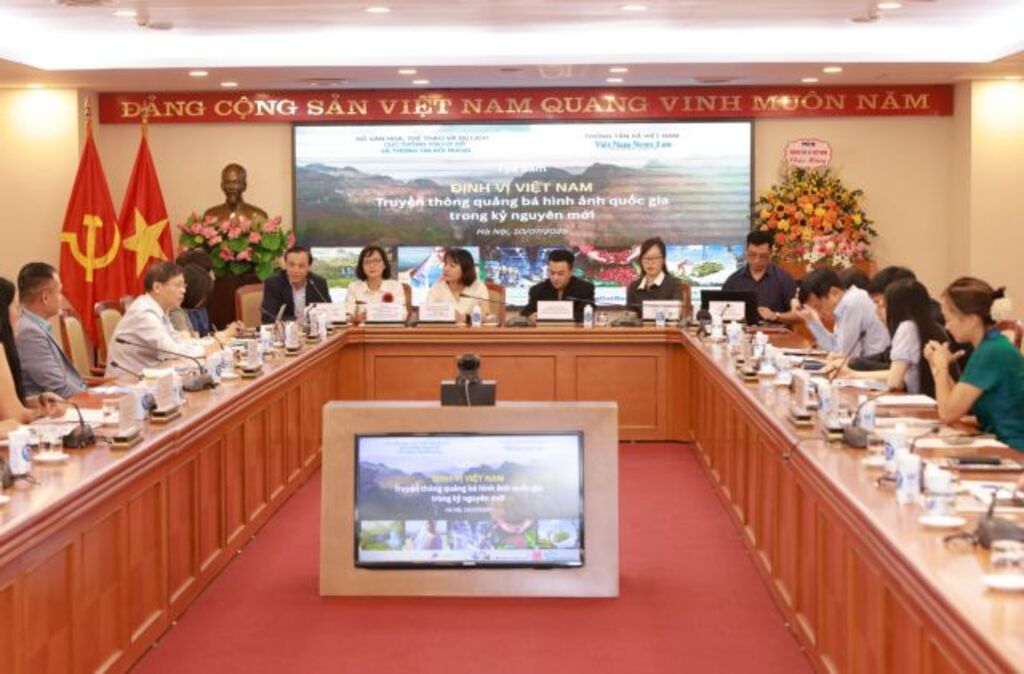 |
| Vu Viet Trang, General Director of the Vietnam News Agency, speaks at the event__Photo: VNS |
As Vietnam enters a new era of nation's rise, the country is placing renewed emphasis on how it presents itself to the world.
At a roundtable on July 10 in Hanoi, titled 'Positioning Vietnam: Promoting the Nation's Image in the New Era', Government officials, diplomats, media executives and scholars came together to discuss how Vietnam can better promote its national image in line with its political, economic and cultural ambitions.
Vu Viet Trang, General Director of the Vietnam News Agency (VNA), stressed that national branding is no longer just the responsibility of the media sector; it must be a central component of Vietnam’s long-term development strategy.
She emphasized that promoting Vietnam’s image is not merely about visibility, but about shaping global perceptions in a way that supports economic growth, cultural development, tourism and international integration.
According to Trang, the national image should reflect a Vietnam that is stable, innovative, dynamic, culturally rich, and friendly. In her view, the media is not just a support mechanism but a key driver of national development goals.
She said: "We need stories that are authentic, emotionally resonant, and inspiring, so the world can understand a Vietnam that is modern and vibrant, yet deeply rooted in tradition."
Trang also laid out four key priorities for VNA in supporting the national branding strategy: diversifying storytelling methods; expanding multilingual content in major world languages; fostering public–private partnerships; and strengthening collaboration with international news agencies.
With a global network of 30 foreign bureaus and over 60 information products in nine languages, VNA plays a pivotal role in connecting Vietnam with the world and vice versa.
Pham Anh Tuan, Director of the Department of Grassroots and External Information under the Ministry of Culture, Sports and Tourism, presented a draft national strategy for promoting Vietnam’s image abroad.
The strategy, developed under the direction of Prime Ministerial Resolution 47, is based on an urgent recognition: Vietnam’s global image has yet to fully reflect its diplomatic, economic, and cultural achievements.
 |
| Guests discuss the strategy to enhance Vietnam’s image on the international stage__Photo: VNS |
"The aim is to move Vietnam from being merely recognized to being chosen and admired," Tuan said, noting that the country must project an image of stability, innovation, cultural richness, and global relevance.
The draft strategy sets ambitious development targets by 2030: for instance, increasing cultural industry contributions to 8 per cent of GDP, boosting tourism’s share to 14 per cent of GDP, attracting at least 35 million international visitors, and securing Vietnam a place among the world’s top 40 nation brands.
The communications focus will center on portraying Vietnam as a peaceful and stable nation, a regional hub for innovation, a country of diverse but unified cultural identities and a destination that is both livable and rich in experience.
The strategy also calls for the use of modern tools - social media, search engine optimization, and digital data platforms - to expand outreach and better target international audiences.
Former ambassador Luong Thanh Nghi, who served in Australia and Denmark, highlighted the significant shift in how foreigners perceive Vietnam.
"In the late 1990s and early 2000s, people still associated Vietnam with poverty," he recalled.
"But now the image has changed - today, it’s graceful women in ao dai stepping out of cars, carrying laptops to work."
According to Nghi, most foreign audiences today see Vietnamese people as peaceful, tolerant, friendly, and hospitable. He estimated that "99 out of 100 people I met recognized these qualities in Vietnamese people".
However, he cautioned that some outdated and simplistic perceptions remain, often perpetuated by films and media content that still depict Vietnam through the lens of wartime hardship.
Some still associate Vietnamese culture only with ao dai, pho and banh my, overlooking the country’s depth and diversity. Nghi emphasized that the media has a vital role to play in reshaping these narratives and helping international audiences understand the full richness of Vietnamese identity.
Do Anh Duc, from the School of Journalism and Communication at the University of Social Sciences and Humanities, proposed a more contemporary and flexible approach to branding the nation, one that focuses not just on content but on context, authenticity, and values.
He introduced the ICON model: Integrated, Contextualized, Organic and New.
• Integrated means engaging the entire political and social system - ministries, agencies, and communities - to coordinate branding efforts.
• Contextualized means adapting messaging to specific audiences. "When we brand Hanoi, for example, we often think of a graceful woman in ao dai," Duc said.
"But a Western visitor might engage with Hanoi through academia, while a businessperson experiences it through commerce. We must offer flexible cultural touch points."
• Organic emphasizes the role of people. "Any campaign that doesn’t have the backing and participation of the public will fail," Duc warned.
• New calls for freshness and depth in storytelling. "It’s not enough to say Vietnam is peaceful and stable," he added. "We must show what we’ve done with that peace - and how it was hard-won."
He also called on communicators to show how Vietnam is translating traditional values into modern strengths. "We must demonstrate that Vietnam can be a developed nation while contributing deeply human values, like community culture and neighborly love, to the global conversation," he said.
Nguyen Thi Phuong Lien, deputy director of Vietnam Television's International Department (VTV4), spoke about the upcoming launch of Vietnam Today - a multimedia channel promoting Vietnam's images scheduled to go live on September 2.
The new platform is intended to offer Vietnam a more global and multidimensional voice in international media.
"We believe that all national image content must be multidimensional and globally relevant," Lien said.
"Vietnam Today won’t just report Vietnam’s story - it will show how Vietnam fits into regional and global issues.”
She gave the example of reporting on Vietnam’s push for investment in science and technology, adding: "Instead of presenting dry statistics, we could host a roundtable with researchers, business leaders and policymakers. That kind of storytelling is more engaging to international investors."
Lien also stressed that successful communication must be human-centered.
"When we tell real stories, like a farmer in a remote village using a smartphone to sell produce online, it resonates more than any abstract figure," she said.
To connect with global audiences, she said, media products must meet four criteria: convey universal values, be authentic and emotional, meet international quality standards, and be accessible across platforms, from traditional media to modern digital channels.
"People might forget the details," she concluded, "but they’ll remember how our stories made them feel."
As Vietnam streamlines its administrative structure and positions itself as a rising power in Southeast Asia, participants at the roundtable agreed: now is the time to tell a more compelling story about who Vietnam is and what it stands for.
The national strategy for image promotion is expected to be submitted to the Government for approval later this month or in August. If implemented effectively, it could not only elevate Vietnam’s visibility on the world stage but turn recognition into admiration and admiration into meaningful engagement.- (VNS/VLLF)









